| dc.contributor.author | de la Vega, Camille | |
| dc.contributor.author | Buchanan, Pearse J. | |
| dc.contributor.author | Tagliabue, Alessandro | |
| dc.contributor.author | Hopkins, Joanne E. | |
| dc.contributor.author | Jeffreys, Rachel M. | |
| dc.contributor.author | Frie, Anne Kirstine Højholt | |
| dc.contributor.author | Biuw, Martin | |
| dc.contributor.author | Kershaw, Joanna | |
| dc.contributor.author | Grecian, James | |
| dc.contributor.author | Norman, Louisa | |
| dc.contributor.author | Smout, Sophie | |
| dc.contributor.author | Haug, Tore | |
| dc.contributor.author | Mahaffey, Claire | |
| dc.date.accessioned | 2022-08-12T11:13:01Z | |
| dc.date.available | 2022-08-12T11:13:01Z | |
| dc.date.created | 2022-05-25T10:00:11Z | |
| dc.date.issued | 2022 | |
| dc.identifier.citation | Global Change Biology. 2022, 28 (9), 3054-3065. | en_US |
| dc.identifier.issn | 1354-1013 | |
| dc.identifier.uri | https://hdl.handle.net/11250/3011607 | |
| dc.description.abstract | Multiple environmental forcings, such as warming and changes in ocean circulation and nutrient supply, are affecting the base of Arctic marine ecosystems, with cascading effects on the entire food web through bottom-up control. Stable nitrogen isotopes (δ15N) can be used to detect and unravel the impact of these forcings on this unique ecosystem, if the many processes that affect the δ15N values are constrained. Combining unique 60-year records from compound specific δ15N biomarkers on harp seal teeth alongside state-of-the-art ocean modelling, we observed a significant decline in the δ15N values at the base of the Barents Sea food web from 1951 to 2012. This strong and persistent decadal trend emerges due to the combination of anthropogenic atmospheric nitrogen deposition in the Atlantic, increased northward transport of Atlantic water through Arctic gateways and local feedbacks from increasing Arctic primary production. Our results suggest that the Arctic ecosystem has been responding to anthropogenically induced local and remote drivers, linked to changing ocean biology, chemistry and physics, for at least 60 years. Accounting for these trends in δ15N values at the base of the food web is essential to accurately detect ecosystem restructuring in this rapidly changing environment. | en_US |
| dc.language.iso | eng | en_US |
| dc.title | Multi-decadal environmental change in the Barents Sea recorded by seal teeth | en_US |
| dc.title.alternative | Multi-decadal environmental change in the Barents Sea recorded by seal teeth | en_US |
| dc.type | Peer reviewed | en_US |
| dc.type | Journal article | en_US |
| dc.description.version | publishedVersion | en_US |
| dc.source.pagenumber | 3054-3065 | en_US |
| dc.source.volume | 28 | en_US |
| dc.source.journal | Global Change Biology | en_US |
| dc.source.issue | 9 | en_US |
| dc.identifier.doi | 10.1111/gcb.16138 | |
| dc.identifier.cristin | 2027219 | |
| cristin.ispublished | true | |
| cristin.fulltext | original | |
| cristin.qualitycode | 2 | |
